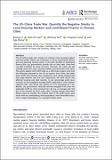The US–China Trade War: Quantify the Negative Shocks to Local Housing Markets and Land-Based Finance in Chinese Cities
Author(s)
Li, Boning; Liao, Wen-Chi; Sun, Weizeng; Zeng, Yongxuan; Zheng, Siqi
DownloadAccepted version (1013.Kb)
Publisher with Creative Commons License
Publisher with Creative Commons License
Creative Commons Attribution
Terms of use
Metadata
Show full item recordAbstract
The US–China trade war’s impacts on Chinese cities’ housing markets and local public finance are examined. In China, institutional reforms and ever-growing housing prices in the past resulted in land-based finance that city governments heavily rely on land sales (state-land use-right transfers) for fiscal revenues. However, the trade war has severely struck the cities’ housing markets and land sales since 2018. This article applies 2016–2019 data to a shift-share analysis and finds the following. Imposed by the US on imports from China, the retaliatory tariffs hurt Chinese cities’ production and caused employment and wage declines and firm exit. Importantly, the tariff shocks also affected housing and land markets. A one percentage point (p.p.) increases in the (weighted average) tariffs applicable to cities’ exports reduced cities’ new home sale volume by 3.1% and prices by 1.2%. Besides, city governments’ land sale revenues dropped 7.6%. Since the applicable tariffs to cities increased by 1.62 p.p. on average and 10.4 p.p. at the extreme by 2019, many cities’ housing markets and public finance have hit trouble. The resilient cities to the tariff shocks were those with less overbuilding, more population, more diversified industries or export destinations, or a stronger tertiary sector.
Date issued
2023-08-23Department
Massachusetts Institute of Technology. Center for Real EstateJournal
Journal of Real Estate Research
Publisher
Informa UK Limited
Citation
Li, B., Liao, W. C., Sun, W., Zeng, Y., & Zheng, S. (2024). The US–China Trade War: Quantify the Negative Shocks to Local Housing Markets and Land-Based Finance in Chinese Cities. Journal of Real Estate Research.
Version: Final published version